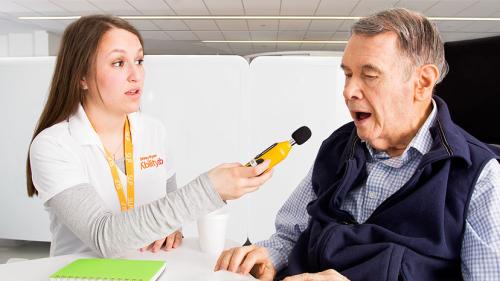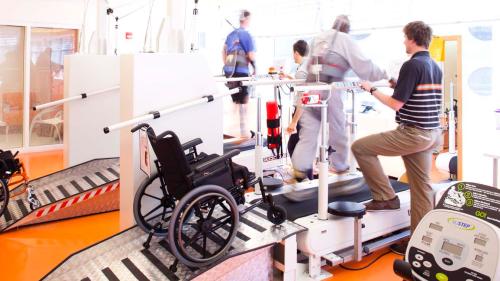What Makes Us Distinct
Body
Shirley Ryan AbilityLab has been treating patients with a standardized Locked-in Syndrome (LIS) care program for nearly 20 years — longer than any other rehabilitation hospital. Richard L. Harvey, MD, Shirley Ryan AbilityLab’s Wesley and Suzanne Dixon Stroke Chair, is the leading LIS expert and has cared for more LIS patients than any other physician in the world.
Shirley Ryan AbilityLab is the only research rehabilitation hospital that has developed a clinical program for treating LIS. Our clinical team understands the unique challenges of treating patients with this condition, including respiratory management and eye care, among many others. The goal is always to maximize recovery and function through the best medical care, therapies, customized equipment and technology.
Dr. Harvey and his team have done extensive research on LIS, some in collaboration with other rehabilitation centers. In a recent article published in PM&R Journal on the management of LIS in rehabilitation, Dr. Harvey concluded that, overall, with specialized rehabilitative care and access to the proper equipment, long-term outcomes and quality of life in LIS patients can be favorable.
Our studies show that some people with Locked-in Syndrome can return home, move about in the community and participate in family activities.
What is Locked-in Syndrome?
Body
Locked-in Syndrome (LIS) is a neurological condition that results from a stroke in the brainstem. The brain stem is the lower part of the brain that’s connected to the spinal cord. It functions as the main pathway for signals between the brain and the body.
After a brainstem stroke, signals from the brain can no longer get through to nerves, preventing movement of the limbs and trunk (quadriplegia) and formation of words with the mouth (anarthria).
Eye movements are also affected, but people with LIS will usually retain the ability to gaze upward and to blink. Despite this extreme paralysis, the person with LIS remains conscious, hearing and thinking.
As a result, he or she can communicate meaningful information, but, initially, is often limited in the means of doing so. Because upward gaze and blinking are preserved, these movements can often be used to answer yes and no questions (e.g., look up means “yes,” and blink means “no”).
As in all strokes, many people with LIS can recover a significant amount of movement and ability, depending on severity of the stroke and the patient’s general health. The faster the neurological recovery, the more complete it will be.
A primary goal of rehabilitation is to maximize use of any retained body control and find new ways to perform actions for those abilities that do not return. The ultimate goals are to minimize the person’s dependence on others, maintain health and simplify medical care over time.
Services for Locked-in Syndrome (LIS)
Body
People with LIS often cannot control ventilation. They may be able to breathe, but only automatically, i.e., with assisted ventilation, a tracheotomy or other intensive respiratory support during initial treatment.
The inability to breathe independently can lead to many challenges in protecting the airway. The patient’s physician collaborates with a respiratory therapist, nursing specialists and occupational, physical and speech-language therapists to determine how best to advance breathing function.
For those patients with LIS who have a tracheostomy tube in the neck to facilitate airway control, we aim, as possible, to improve respiratory function so that the tracheostomy tube can be removed.
Eye-care Management
People with LIS often have limited eye movement and sometimes cannot fully close their eyes. As a result, eye infection is common. In addition, people with LIS can have double vision. To manage eye care, the patient's Shirley Ryan AbilityLab care team includes a neuro-optometrist and a specially trained vision therapist.
An occupational therapist evaluates a patient’s vision, head control, upper extremity function, functional cognition and ability to engage in activities of daily living.
On the first day of occupational therapy, therapists will assess the patient’s eye range of motion and any functional movements they may be able to perform. This evaluation is conducted to access simple communication systems through eye gaze or simple control buttons.
Occupational therapy goals primarily focus on improving head control, upper-extremity function and sitting balance in order to improve the ability to participate in daily tasks. As patients progress, they will try out strategies to be more independent at home or to direct their own care. Patients will work with an assistive technology occupational therapist to try out assistive devices in order to access technology and communication devices.
Family members may be trained to assist the patient with range-of-motion exercises, and the therapist will work with an orthotics team to determine the most appropriate splints for arm and hand positioning. Finally, occupational therapists will assist with determining required equipment and ensure that the patient’s family is trained to assist with daily tasks, including dressing, bathing, toileting and grooming.
A physical therapist (PT) is involved in assessing the patient’s mobility skills. He or she evaluates the patient’s range of motion, strength, sensation, functional mobility and balance. The patient’s PT also works closely with a seating and positioning therapist to identify the most appropriate wheelchair or mobility device.
When possible, the PT may also work with the patient on standing, stepping and walking using the advanced technology and devices that the Shirley Ryan AbilityLab has to offer or creates.
A PT may also work closely with a Shirley Ryan AbilityLab orthotist to evaluate the patient for any needed bracing. Such orthoses would be designed to prevent or decrease any range-of-motion loss.
As the OT has done, a speech-language pathologist (SLP) will perform an initial short assessment to attempt to recognize and/ or establish a simple form of communication.
The purpose of this step is to give the patient the ability to communicate basic needs to staff and family members until a more sophisticated system can be developed. This early form of communication may include using eye movements, head movements or a switch system that can be activated with head or arm movements.
The SLP’s primary purpose is to assess and treat any impairment in the patient’s cognitive and communication skills, motor speech abilities and swallowing.
Where appropriate, the SLP collaborates with a therapist from the Assistive Technology Center. Assistive technology may include high-tech, custom tools that aid in communication, learning, operation of mobility or household devices such as a power wheelchair, a TV remote and a modified phone, among others.
Patients with LIS may be able to use blinking, eye gaze or other movements to communicate with the help of picture boards or alphabet spelling. The SLP then practices the use of this system with the patient, family and staff to facilitate more effective and efficient communication of needs, wants, feelings, responses to questions or comments, and so forth.
Cognition, including attention and short-term memory, are also assessed and treated by the SLP if impairments in these areas interfere with the patient’s ability to communicate.
The SLP also examines the patient’s muscles and structures necessary for speech production and swallowing. If indicated, the SLP can target patient-specific exercises and drills to improve oral movements, as well as the ability to voice and swallow. The SLP may also recommend an Oral Pharyngeal Swallow Study (OPSS) to further evaluate the patient’s swallowing ability and determine the appropriate course of swallowing therapy.
Education & Preparation for Discharge
Before leaving the inpatient stroke unit at Shirley Ryan AbilityLab, you and all involved family members and caregivers will have the opportunity to learn how to perform all care from members of the patient’s care team.
Physical, occupational and speech therapists will instruct in the proper use of equipment and communication devices, as necessary. The PT works in conjunction with the OT to order the most appropriate bathing, toileting and transferring equipment needed upon discharge and will educate patients, families and caregivers on use of equipment. Nurses will teach proper administration of medications and other nursing-care basics. Care managers will help you prepare for discharge to home or to the next facility.
The family and/or caregiver also works closely with the PT who will educate and train them on assisting the patient with all aspects of mobility, positioning and range-of-motion exercises. Finally, the PT works closely with patients and families to address any home-modification needs (e.g., entrance ramps, a special shower or toilet).
After discharge, the patient will have a case manager available to help solve problems that arise. Whether the person with Locked-in Syndrome goes home or to a skilled nursing facility, it is very beneficial for family members to learn as much as possible. Doing so allows you to advocate for the patient and, on occasion, to comfortably take the patient out of the facility for a visit home or an outing.
The following programs and services are also available to all patients should they be able to participate.



